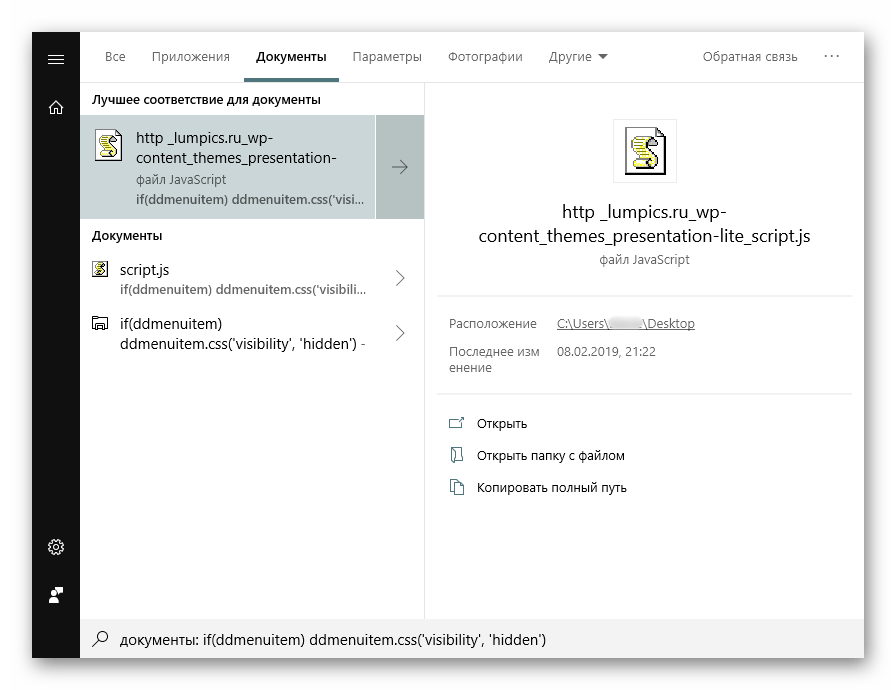Все способы:
- Поиск файлов по содержимому в Виндовс 10
- Способ 1: Сторонние программы
- Способ 2: Поиск через «Пуск»
- Вопросы и ответы: 18
Для многих пользователей основным местом хранения практически любой электронной информации является жесткий диск в компьютере или флешка. Со временем данных может накапливаться большое количество и даже качественная сортировка и структуризация могут не помочь — без дополнительной помощи отыскивать нужное станет сложно, особенно когда помнишь содержимое, но не помнишь имя файла. В Windows 10 есть сразу два варианта того, как искать файлы по их отрывку.
Поиск файлов по содержимому в Виндовс 10
В первую очередь с данной задачей ассоциируются обычные текстовые файлы: мы сохраняем на компьютере различные заметки, интересные сведения из интернета, рабочие/учебные данные, таблицы, презентации, книги, письма из почтового клиента и многое другое, что можно выразить текстом. Помимо этого по содержимому можно искать и узконаправленные файлы — сохраненные страницы сайтов, код, хранящийся к примеру, в расширении JS и др.
Способ 1: Сторонние программы
Обычно функциональности встроенного поисковика Windows достаточно (о нем мы рассказали в Способе 2), но сторонние программы в ряде случаев будут приоритетнее. К примеру, настройка параметров расширенного поиска в Виндовс устроена таким образом, что вы делаете ее один раз и надолго. Вы также можете выставить поиск по всему накопителю, но при большом количестве файлов и объемном жестком диске процесс иногда замедляется. То есть гибкости системой не предусмотрено, сторонние же программы позволяют каждый раз искать по новому адресу, сужая критерии и используя дополнительные фильтры. К тому же такие программы часто выступают небольшими файловыми помощниками и имеют расширенные возможности.
В этот раз мы рассмотрим работу простой программы Everything, поддерживающей поиск на русском языке локально, на внешних девайсах (HDD, флешка, карта памяти) и на серверах FTP.
Скачать Everything
- Скачайте, установите и запустите программу обычным способом.
- Для обычного поиска по названию файла достаточно воспользоваться соответствующим полем. При параллельной работе с другим ПО результаты будут обновляться в режиме реального времени, то есть если вы сохранили какой-то файл, соответствующий введенному имени, он тут же добавится в выдачу.
- Для поиска по содержимому переходим в «Поиск» > «Расширенный поиск».
- В поле «Слово или фраза внутри файла» вписываем искомое выражение, при необходимости настроив дополнительные параметры типа фильтра по регистру. Чтобы ускорить процесс поиска, можете также сузить область проверок, выбрав конкретную папку или приблизительную область. Этот пункт желателен, но необязателен.
- Появится результат, соответствующий заданному вопросу. Вы можете открыть каждый найденный файл двойным кликом ЛКМ или вызвать его стандартное контекстное меню Windows, нажав ПКМ.
- Кроме того, Everything справляет с поиском специфического контента, как, например, скрипта по строчке его кода.
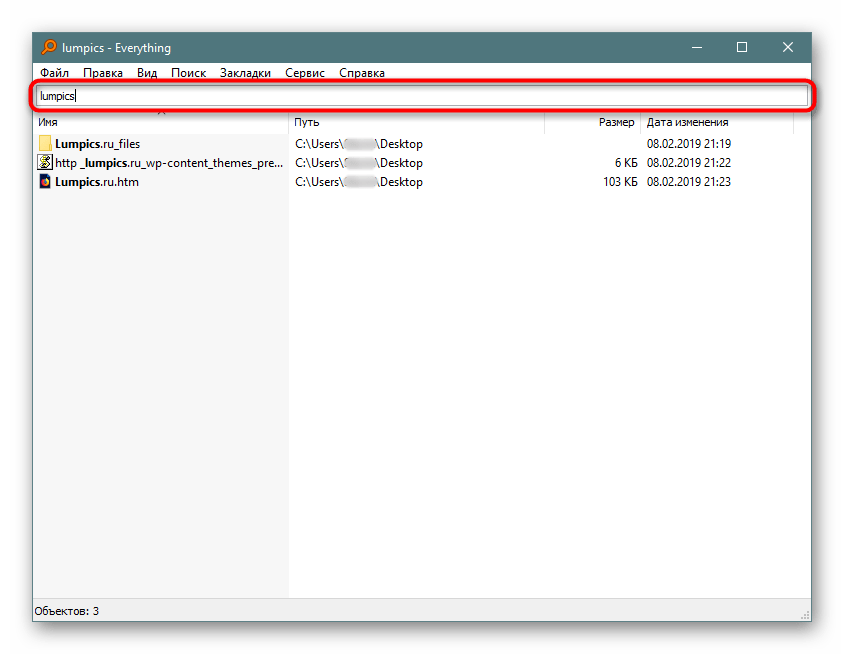
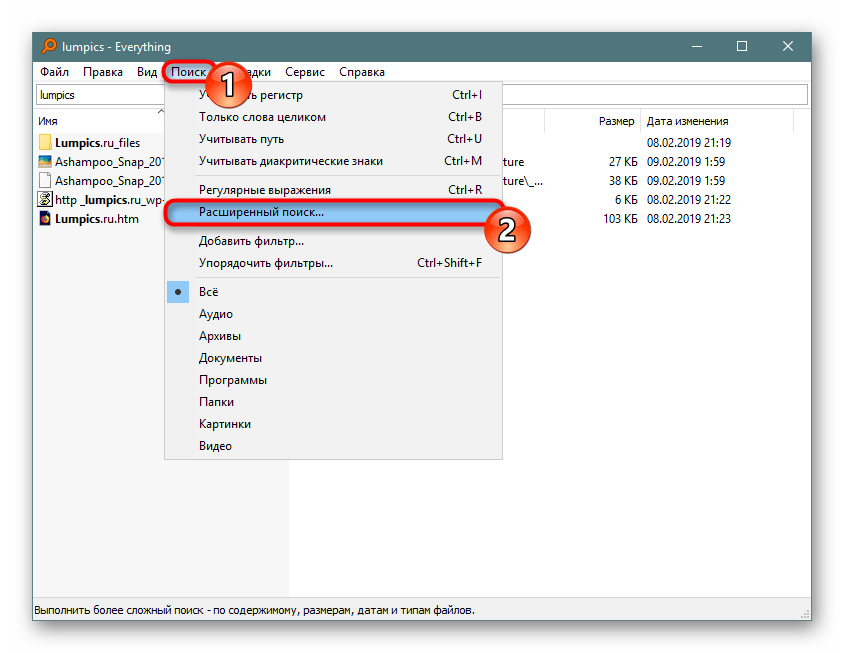
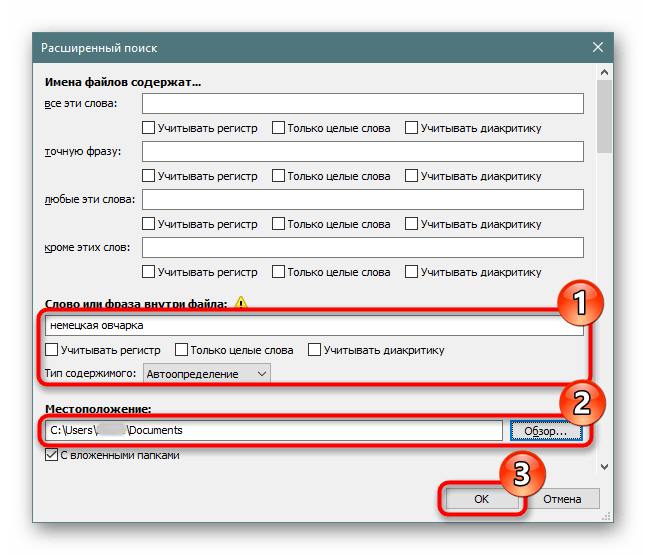
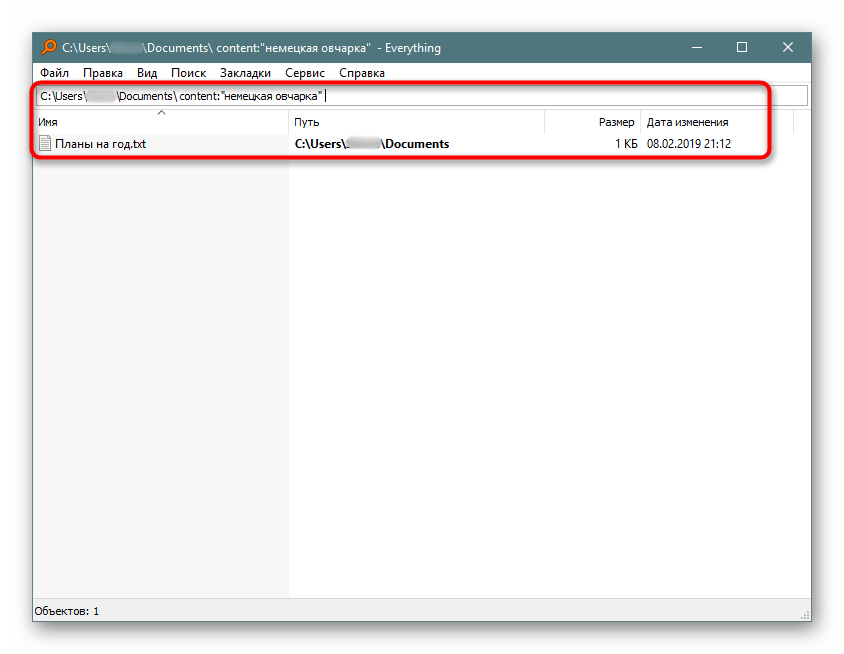
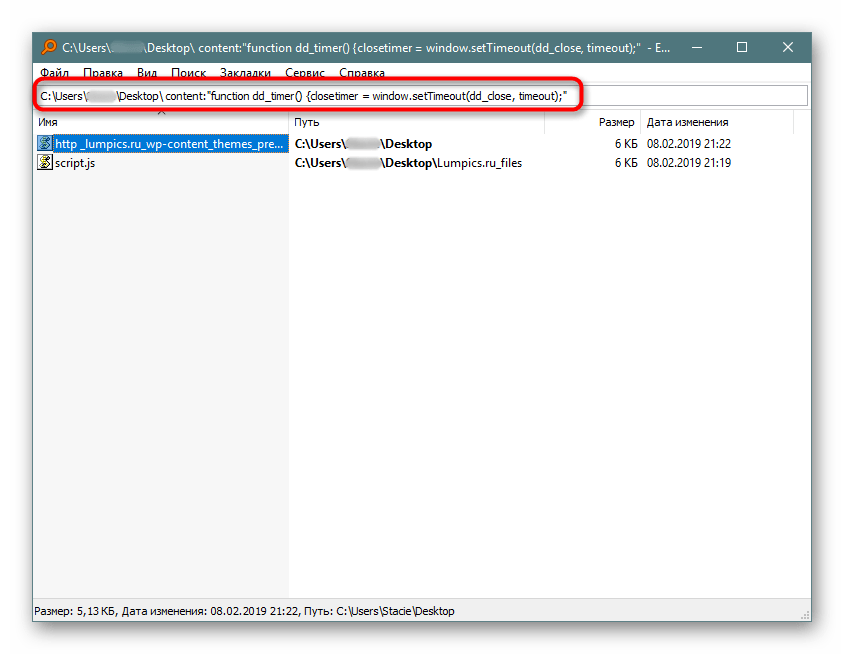
Остальные возможности программы вы можете узнать из нашего обзора программы по ссылке выше или самостоятельно. В целом это очень удобный инструмент, когда требуется быстро искать файлы по их содержимому, будь то встроенный накопитель, внешний диск/флешка или FTP-сервер.
Если работа с Everything не подходит, ознакомьтесь со списком других похожих программ по ссылке ниже.
Читайте также: Программы для поиска файлов на компьютере
Способ 2: Поиск через «Пуск»
Меню «Пуск» в десятке было улучшено, и сейчас оно не такое ограниченное, как было в прошлых версиях этой операционной системы. Используя его, можно отыскать нужный файл в компьютере по его содержимому.
Для того чтобы этот способ был рабочим, необходима включенная расширенная индексация на компьютере. Поэтому первым делом разберем, как ее активировать.
Включение службы
У вас должна быть запущена служба, отвечающая за поиск в Виндовс.
- Чтобы это проверить и при необходимости изменить ее статус, нажмите Win + R и в поисковое поле впишите
services.msc, затем нажмите Enter. - В списке служб отыщите «Windows Search». Если в колонке «Состояние» статус «Выполняется», значит она включена и дальнейшие действия не требуются, окно можно закрыть и переходить к следующему этапу. Тем, у кого она отключена, нужно ее запустить вручную. Для этого нажмите два раза по службе левой кнопкой мыши.
- Вы попадете в ее свойства, где «Тип запуска» смените на «Автоматически» и нажмите «ОК».
- Вы можете «Запустить» службу. Статус в столбце «Состояние» не сменится, однако если вместо слова «Запустить» вы увидите ссылки «Остановить» и «Перезапустить», значит включение произошло успешно.
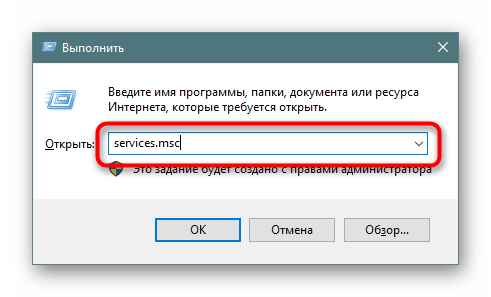

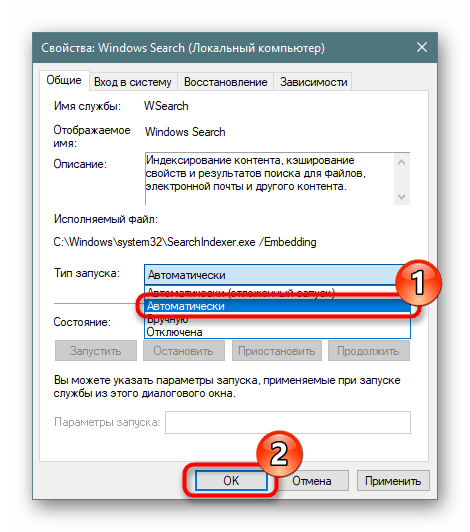
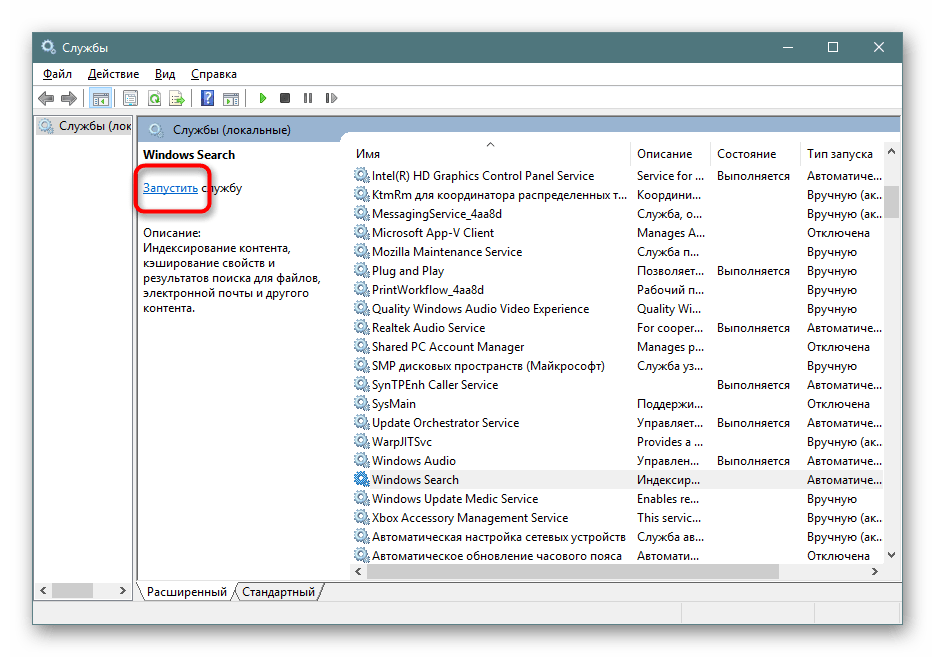
Включение разрешения индексации на жестком диске
Жесткий диск должен иметь разрешение на индексацию файлов. Для этого открываем «Проводник» и переходим в «Этот компьютер». Выбираем тот раздел диска, на котором планируется совершать поиск сейчас и в будущем. Если таких разделов несколько, выполните дальнейшую настройку поочередно со всеми ними. При отсутствии дополнительных разделов работать будем с одним — «Локальный диск (С:)». Жмем правой кнопкой мыши по иконке и выбираем «Свойства».
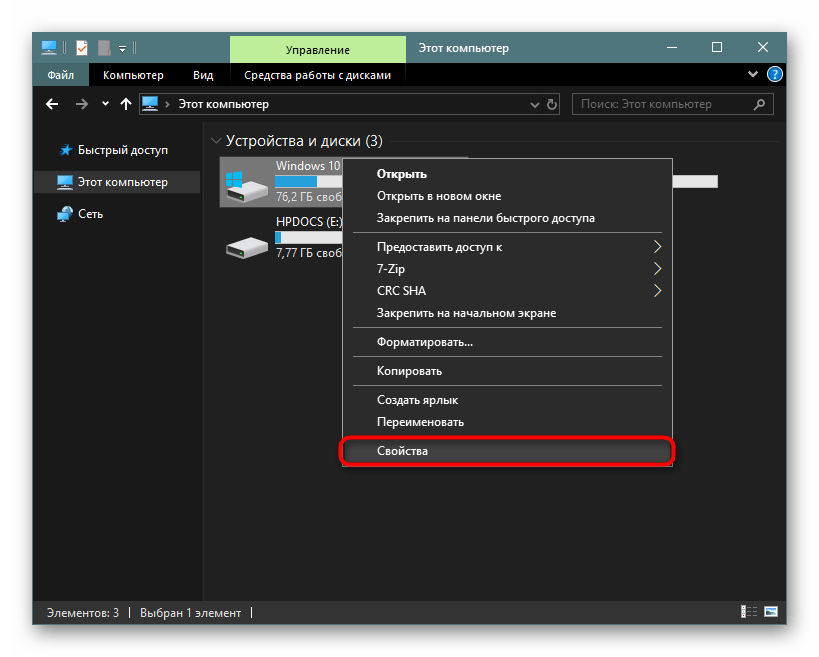
Убедитесь, что галочка рядом с пунктом «Разрешить индексирование…» установлена или поставьте ее самостоятельно, сохранив изменения.
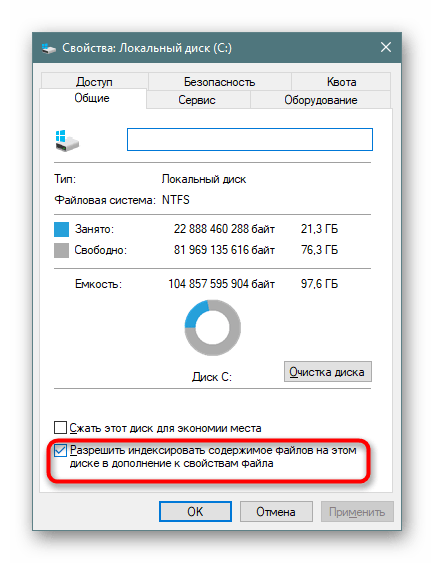
Настройка индексации
Теперь остается включить расширенную индексацию.
- Открываем «Пуск», в поисковом поле пишем что угодно, чтобы запустить меню поиска. В правом верхнем углу жмем по троеточию и из выпавшего меню кликаем на единственный доступный вариант «Параметры индексирования».
- В окне с параметрами первым делом добавим место, которое будем индексировать. Их может быть несколько (например, если вы хотите индексировать папки выборочно или несколько разделов жесткого диска).
- На скриншоте ниже видно, что для индексирования добавлена одна лишь папка «Downloads», которая находится на разделе (D:). Все те папки, что не были отмечены галочками, индексироваться не будут. По аналогии с этим вы можете настроить раздел (C:) и другие, если таковые имеются.
- В колонку «Исключения» попадают папки внутри папок. Например, в папке «Downloads» снятая галочка с подпапки «Photoshop» добавила ее в список исключений.
- Когда вы детально настроили все места индексирования и сохранили результаты, в прежнем окне нажмите кнопку «Дополнительно».
- Переходим на вкладку «Типы файлов».
- В блоке «Как следует индексировать такие файлы?» переставляем маркер на пункт «Индексировать свойства и содержимое файлов», жмем «ОК».
- Будет начато индексирование. Цифра обработанных файлов обновляется где-то раз в 1-3 секунды, а общая продолжительность зависит лишь от того, какой объем информации предстоит проиндексировать.
- Если по какой-то причине процесс не запускается, снова зайдите в «Дополнительно» и в блоке «Устранение неполадок» щелкните на «Перестроить».
- Согласитесь с предупреждением и дождитесь, когда в окне будет написано «Индексирование завершено».
- Все лишнее можно закрыть и попробовать работу поиска в деле. Открываем «Пуск» и пишем фразу из какого-нибудь документа. После этого на верхней панели переключаем тип поиска с «Все» на подходящий, в нашем примере на «Документы».
- Результат на скриншоте ниже. Поисковик отыскал вырванную из текстового документа фразу и нашел ее, предоставив возможность открыть файл, отобразив его расположение, дату изменения и другие функции.
- Помимо стандартных офисных документов Windows умеет искать и по более специфическим файлам, например, в JS-скрипте по строчке кода.
Или в HTM-файлах (обычно это сохраненные страницы сайтов).
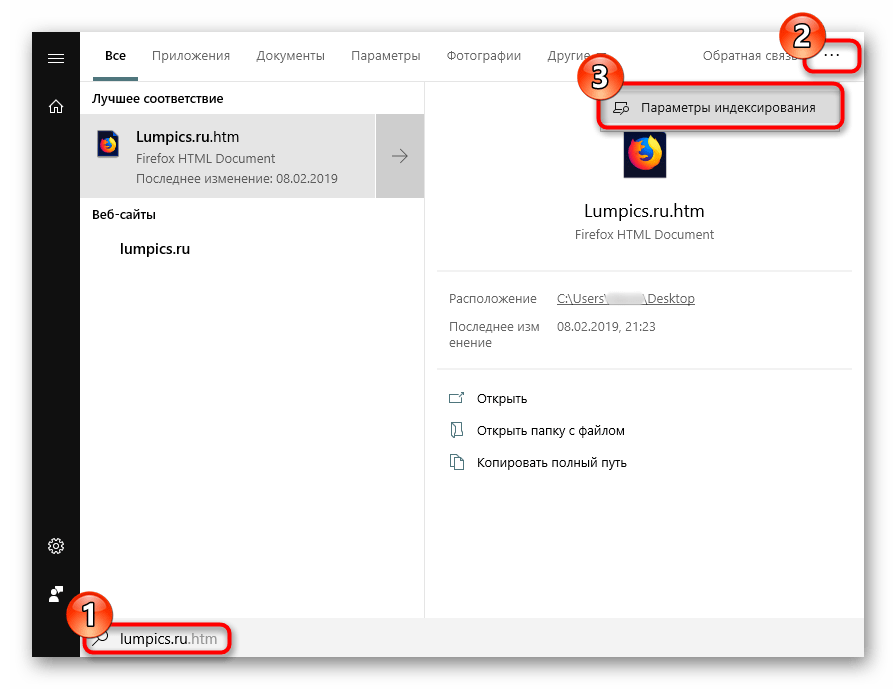
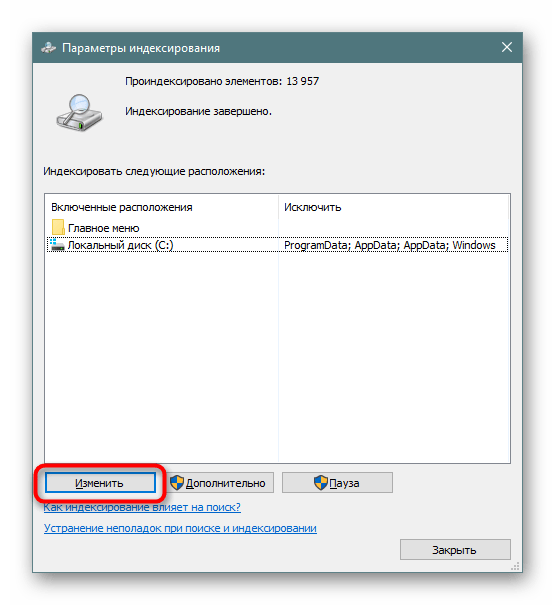
Напоминаем, что здесь надо выбирать те места, в которых вы планируете совершать поиск в дальнейшем. Если выбирать сразу весь раздел, в случае с системным будут исключены самые важные его папки. Это сделано и в целях безопасности, и для сокращения времени ожидания поиска. Все остальные настройки касательно индексируемых мест и исключений при желании настройте самостоятельно.
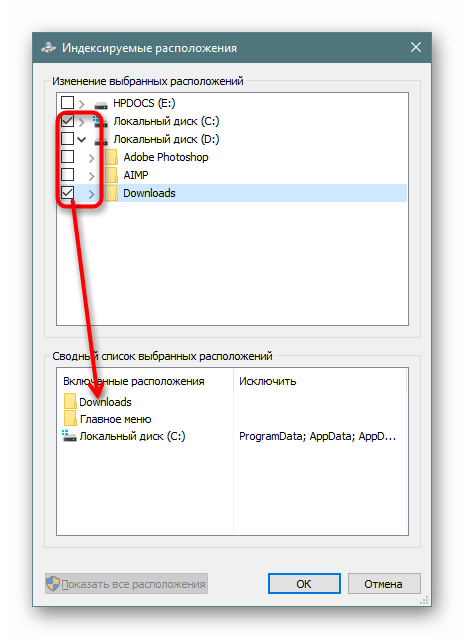
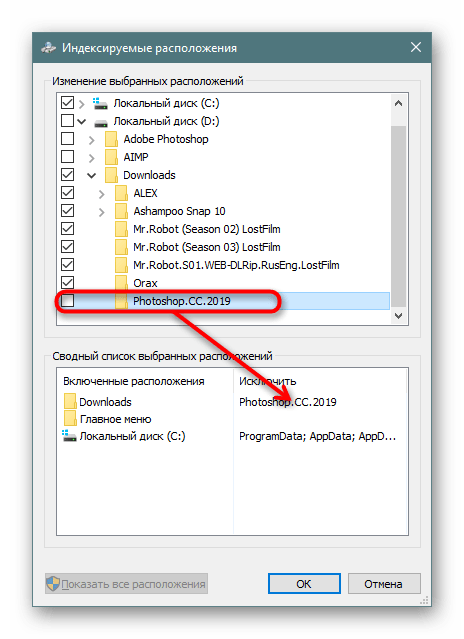
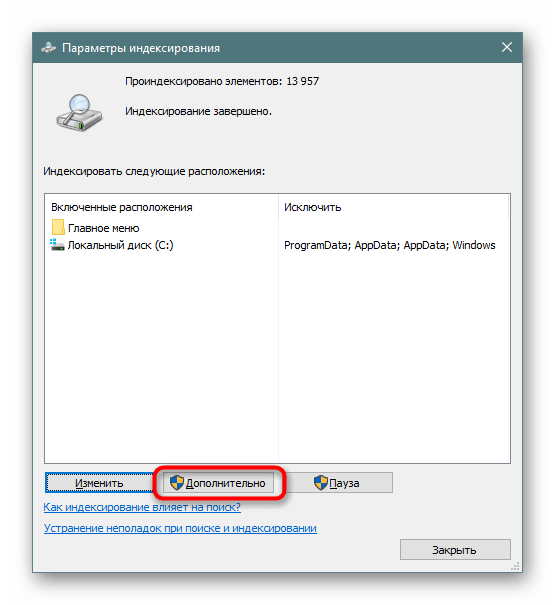
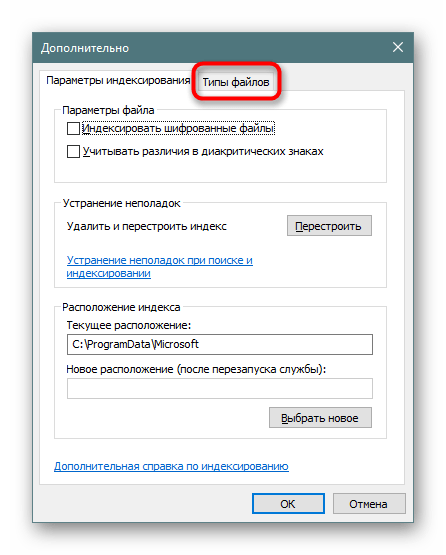
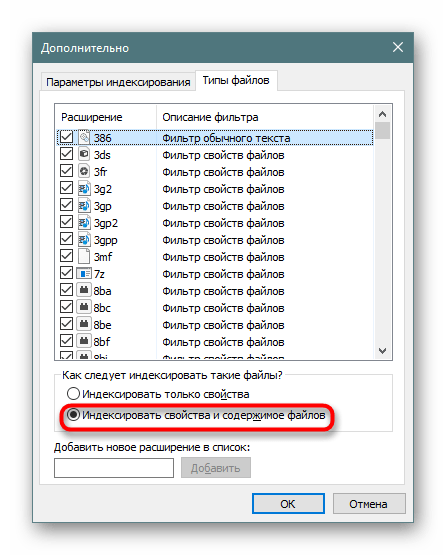
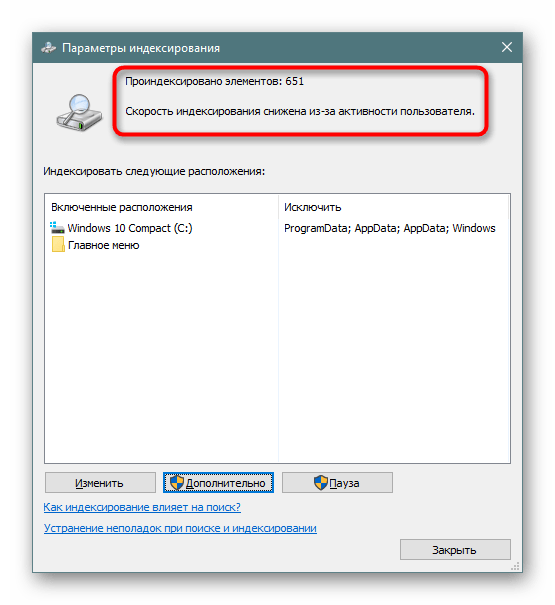
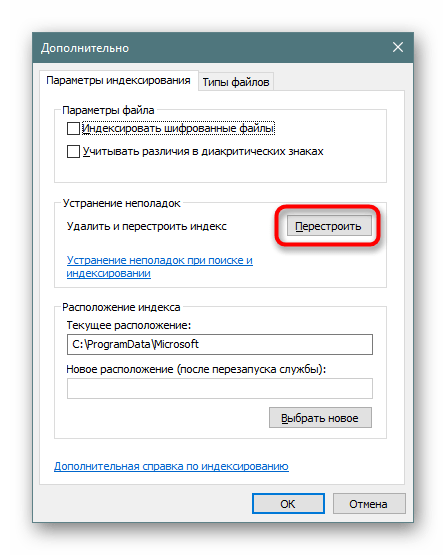
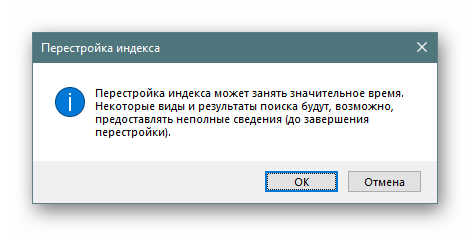
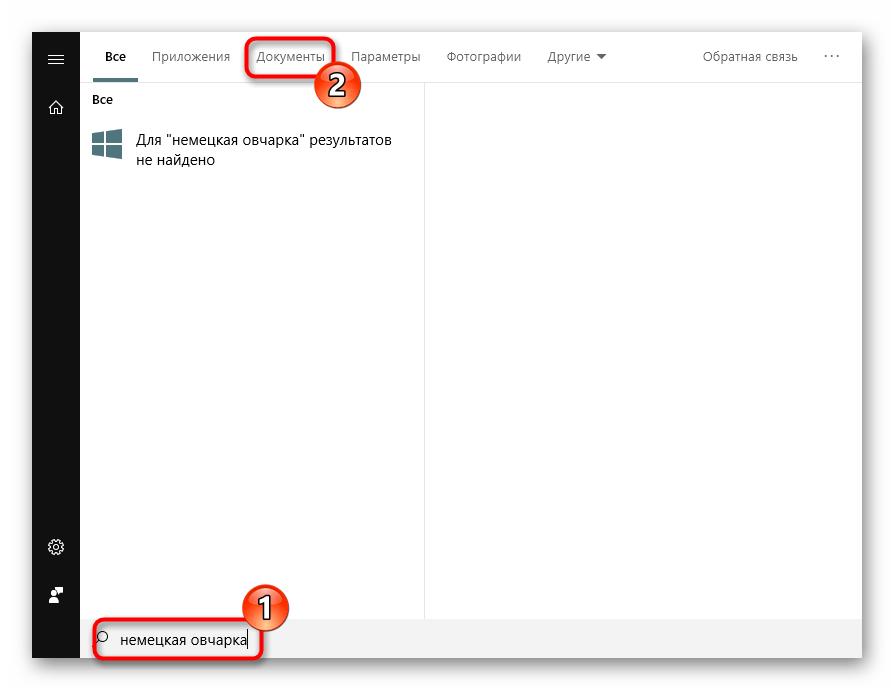
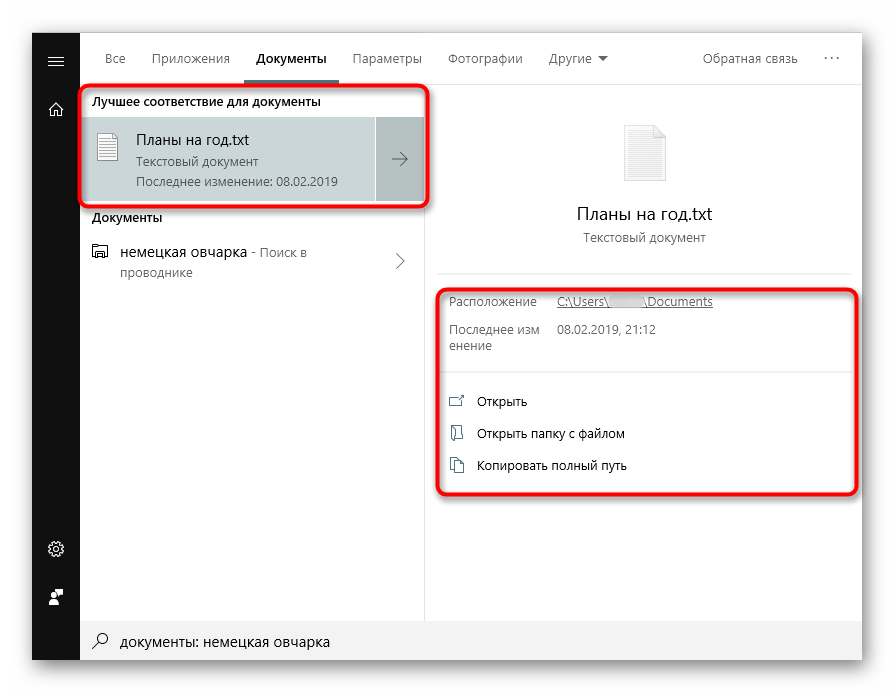
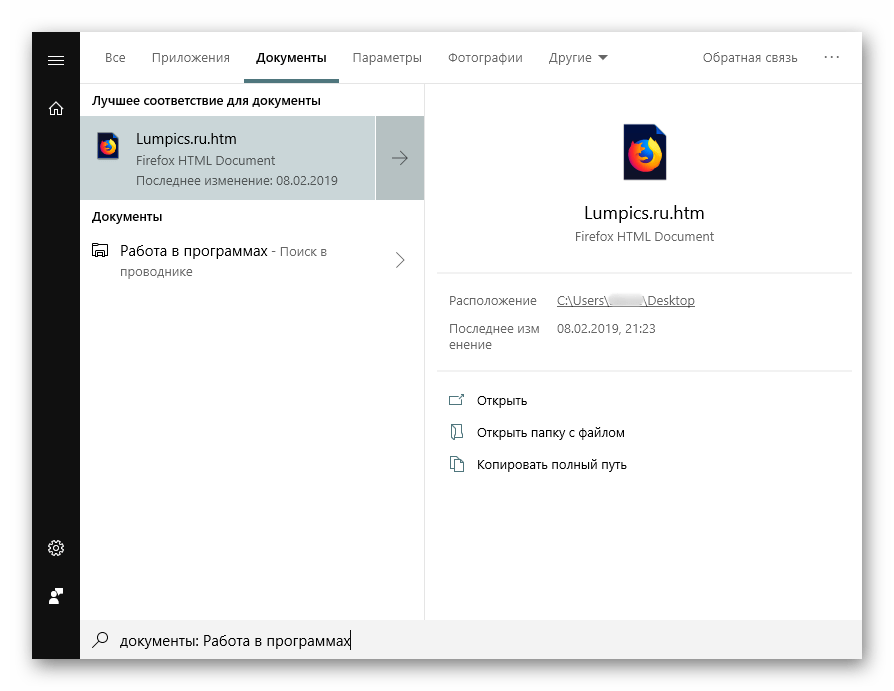
Конечно, полный список файлов, которые поддерживает поисковик десятки, куда больше, и показывать все примеры не имеет смысла.
Теперь вы знаете, как оптимизировать поиск по содержимому в Windows 10. Это позволит сохранять больше полезной информации и не теряться в ней, как прежде.
Наша группа в TelegramПолезные советы и помощь
Довольно часто бывает такое — написал текст, сохранил, а под каким названием был файл, со временем забыл. Либо компьютер просто захламлен большим количеством мусора из файлов и отыскать нужный файл помогут как штатные средства ОС Windows, так и сторонние ПО.
Открываем каталог/папку, где предполагаем начать поиск файла (в моем случае это рабочий стол), в окне справа находим поле поиска, в котором будет написано: «Поиск: Рабочий стол» (если поиск подразумевается в другой папке, то вместо «рабочий стол» будет название папки). Щелкаем правой кнопкой мыши по этому полю и вводим слово или фразу по которой ходит найти файл.
В моем случае нашлось два файла, которые содержат внутри слово «Windows»:
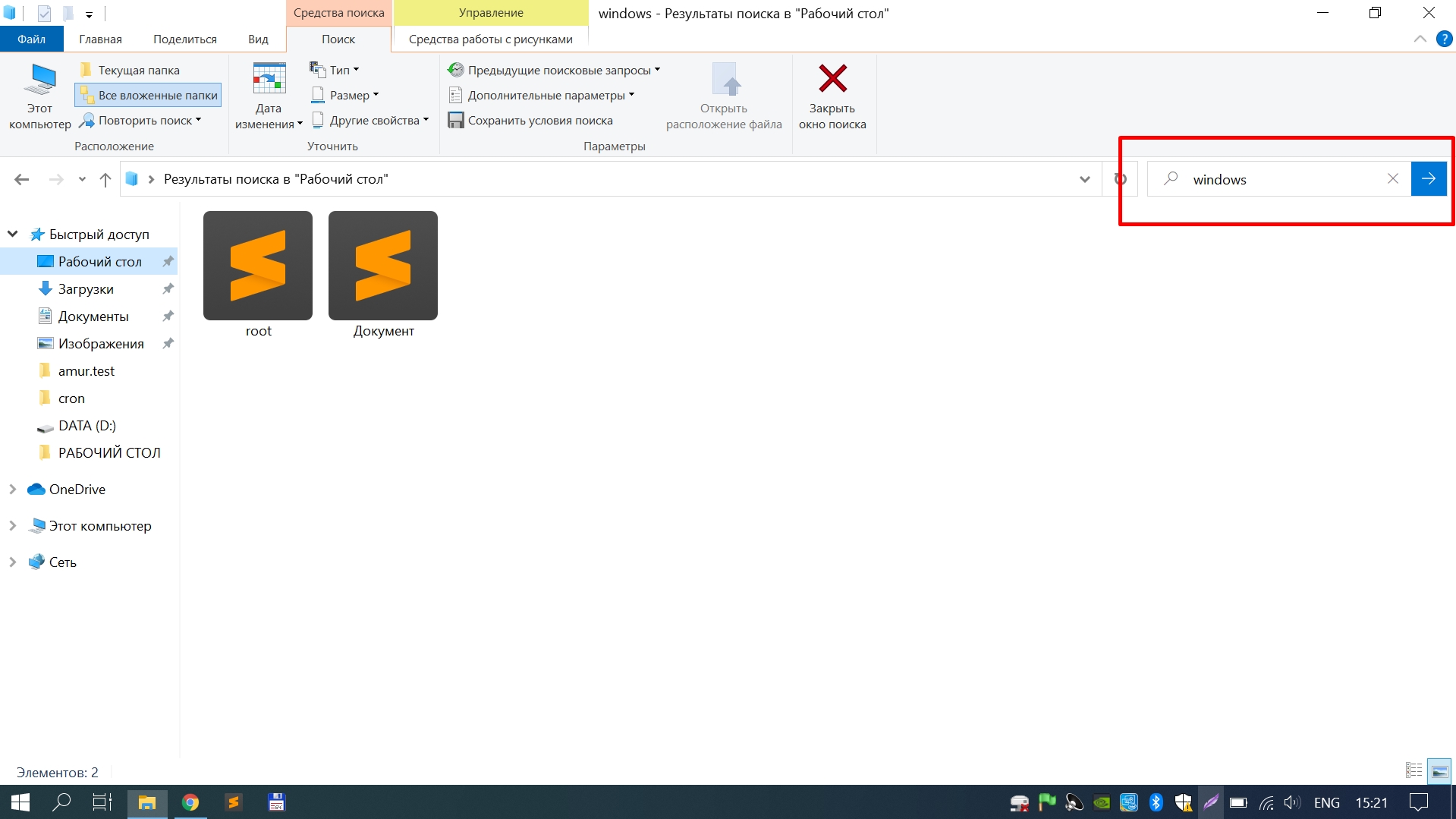
Для поиска в документах MS Office необходимо перейти во вкладку «Поиск», в «Дополнительные параметры» отмечаем пункт «Содержимое файлов»:

Способ 2. Поиск через Total Commander
Открываем ПО Total Commander, на панели управления находим кнопку с «лупой» — кнопку поиска. Либо нажимаем «Команды» — «Поиск файлов…». Либо нажимаем на клавиатуре сочетание клавиш «Alt+F7». Во всех трех случаях откроется окно поиска файлов. Во вкладке «Общие параметры» выбираем в пункте «Место поиска» путь, по которому будем производить поиск, далее отмечаем галочку «С текстом» и пишем искомую фразу или слово, по завершении нажимаем кнопку «Начать поиск»:
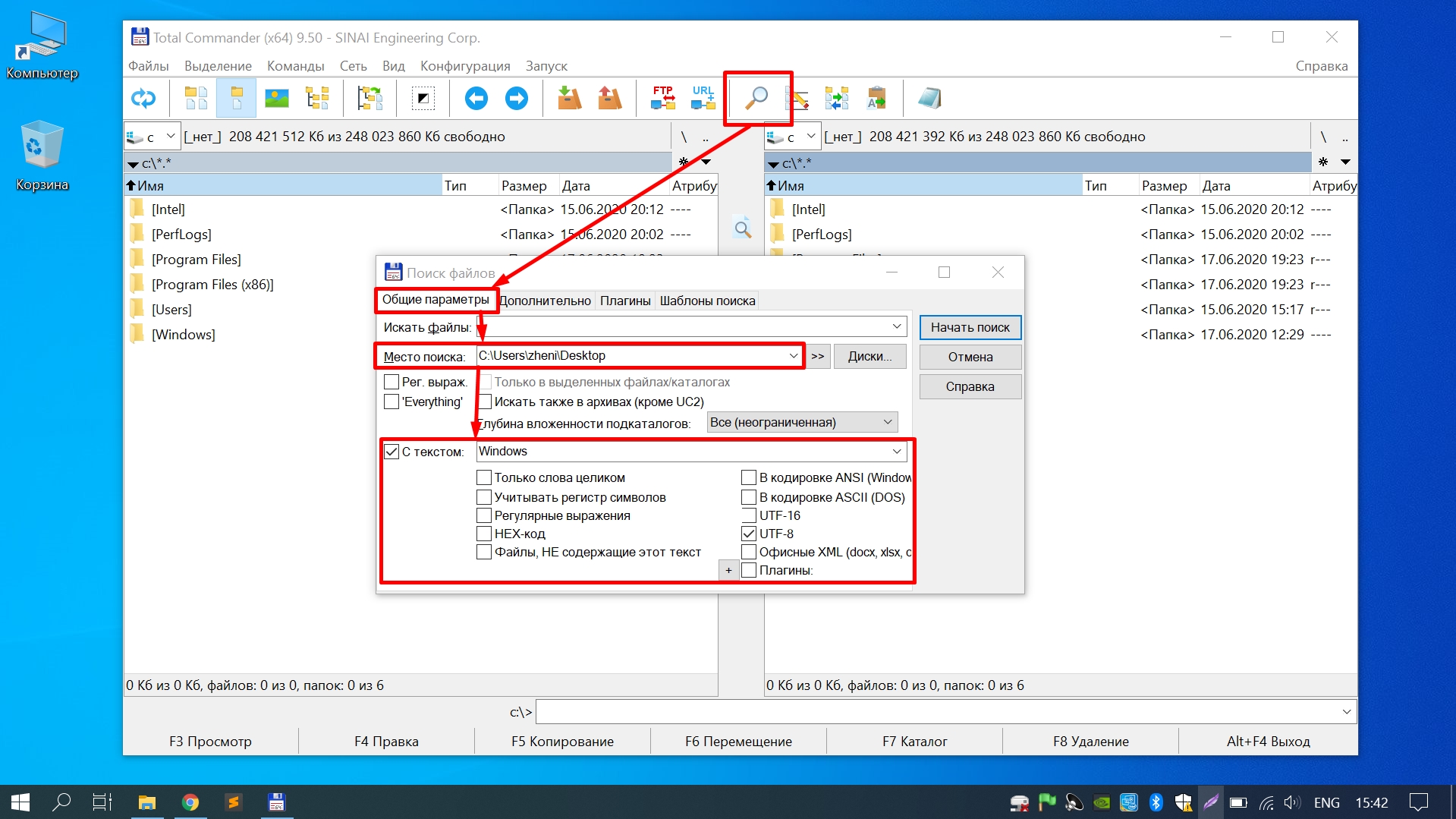
Если система найдет файлы, результат будет следующим:

Способ 3. Поиск через Notepad++
Открываем ПО Notepad++, щелкаем «Поиск» — «Найти в файлах», либо нажимаем на клавиатуре клавиши «Ctrl+Shift+F». В появившемся окне поиска в пункте «Папка» выбираем путь для поиска, а в пункте «Найти» указываем искомое слово, затем щелкаем кнопку «Найти все» и радуемся результату поиска:
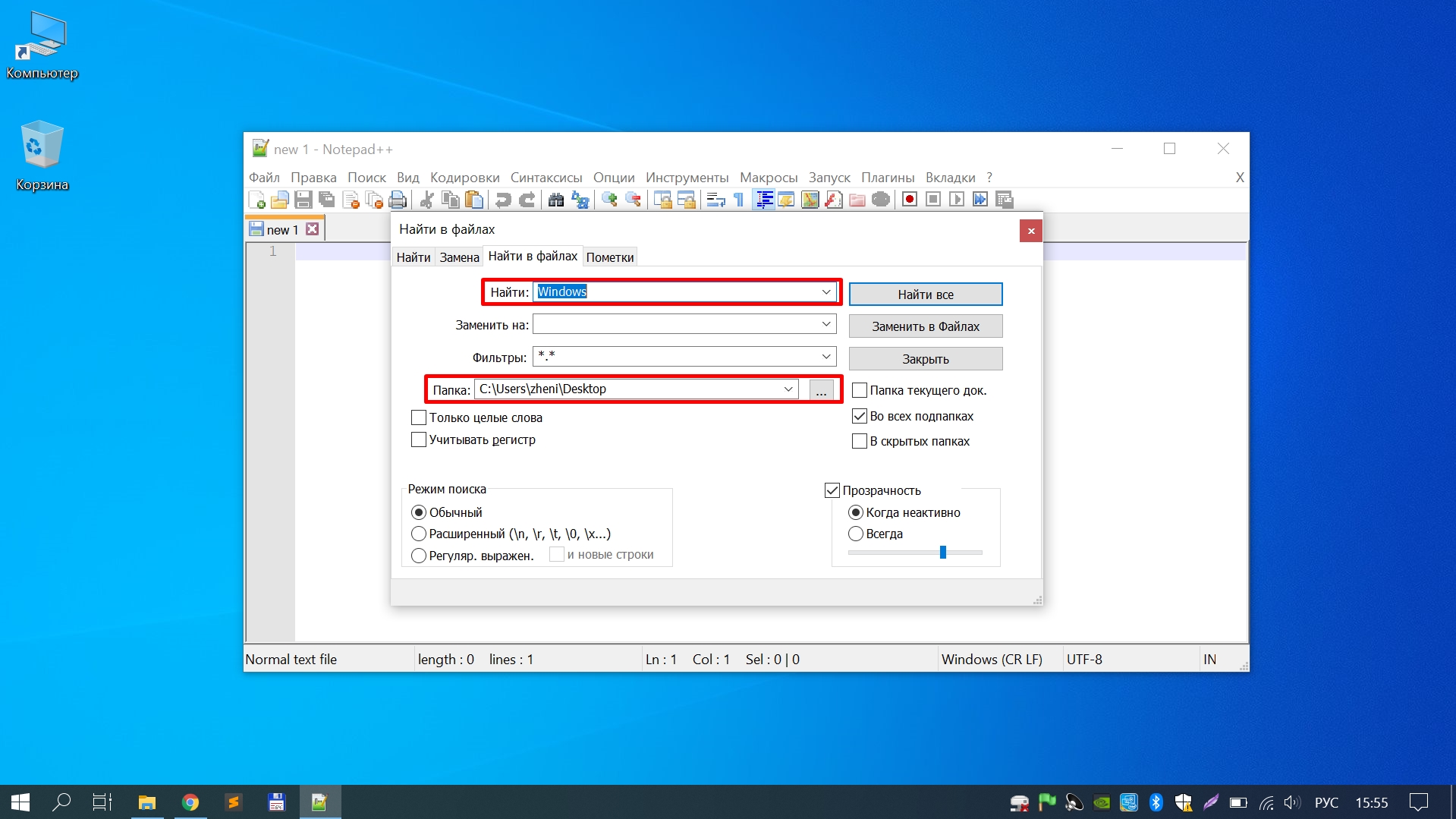
Search through file contents in Windows 10: Laptops or PCs are the storage devices where you keep all your data like files, images, videos, documents, etc. You store all kind of data and data from other devices such as phones, USB, from the Internet, etc is also saved on your PC. All the data is saved in different folders depending on the location where that data is saved.
So, if you want to look for a particular file or app, then what will you do?? If you are planning to open each and every folder and then look for that particular file or app in it, then it will consume a lot of your time. Now to solve the above problem Windows 10 comes with a feature which enables you to search whatever file or app you are looking for, by just typing it in the search box.

Also, it not only provides you an opportunity to search for a particular file but also lets you search among the contents of the files by simply typing what you looking for. Although most of the people are not aware that this feature exists in Windows 10, so to use this feature first you need to enable it. So, in this guide, you will see how to enable the feature that will allow you to search among the contents of the file and other various searching options available in Windows 10.
Table of Contents
Make sure to create a restore point just in case something goes wrong.
Method 1: Search using the Search box or Cortana
The basic search option that is available in all the versions of Windows is a search bar available at the Start Menu. Windows 10 Search bar is more advanced than any of the previous search bar’s. And with the integration of Cortana (the virtual assistant of Windows 10) you can not only search for files under your local PC but you can also discover files available on Bing and other online sources.
To search any file using the search bar or Cortana follow the below steps:
1.Click on the Start Menu and a search bar will appear.
2.Type the name of the file you want to search.
3.All the possible results will appear, then you will have to click on the file that you were looking for.
Method 2: Search using the File Explorer
If you’re looking for a file and if you know in which folder or drive it is under then you can search for the file directly using the File Explorer. It will take less time for the file to be found and this method is quite easy to follow.
To do so, follow the below-given steps:
1.Press Windows Key + E to open File Explorer.
2.From the left side choose the folder under which your file is present. If you don’t know the folder then click on This PC.
3.A search box will appear on the top-right corner.

4.Type the file name you want to search and the required result will appear on the same screen. Click on the file you want to open and your file will open up.
Method 3: Using the “Everything” tool
You can also use a third-party tool called “Everything” to search for any file on your PC. It is very fast as compared to inbuilt search features and is very simple to use. It creates a search index of PCs within a few minutes and when you use the same, it starts working immediately. It is very lightweight and handy application.
If you want to quickly search any file on your computer then Everything tool is the best solution as compared to other integrated searching tools.
All the three methods above will give only file names and folders available on your PC. They will not give you the content of the file. If you want to search the content of the requisite file, then go for the below method.
Method 4: Search for Text or Contents of Any File
Searching through the file content is possible in Windows 10 by using the Start Menu Search. If you are unable to do so, then it is because that feature is turned off by default. So, in order to use this feature, you need to enable this feature.
To enable searching among file content feature, follow the below steps:
1.Open the Cortana or search bar and type Indexing options in it.
2.Click on the Indexing Options that will appear as a result on top or simply hit the enter button on the keyboard. Below a dialog box will appear.

3.Click on the Advanced button available at the bottom.

4.Under Advanced Options, click on File types tab.
5.Below a box will appear in which by default all the extensions are selected.
Note: As all the file extensions are selected, this will allow you to search through the contents of all types of files available under your PC.
6.Check the radio button next to Indexed Properties and File contents option.
7.Click on OK.
8.A Rebuilding Index warning box will appear which gives you a warning regarding some content may not be available under search until the rebuilding is finished. Click OK to close the warning message.
Note: Rebuilding the index might take a long time to complete depending upon the number & size of the files on your PC.
9.Your indexing is in process.
10.Click close on the Advanced options dialog box.

After the indexing is completely finished, now you can search for any text or word in any file using the File Explorer. To do so, follow the below-given steps:
1.Press Windows Key + E to open File Explorer.
2.From the left side, choose “This PC“.
3.Now from the right top corner, a search box is available.
4.Type the text in the search box you want to search among the content of the available files. All the possible result will appear on the same screen.

Note: If you do not get any result, then it is possible that indexing has not been completed yet.
This will give you all the results which include both the content of files as well as the file names which contain that particular text which you searched.
Recommended:
- 9 Best Free Email Service Providers of 2019: Review & Comparison
- 7 Best Pirate Bay Alternatives That Work In 2019 (TBP Down)
- Creating a Full System Image Backup in Windows 10
- 5 Best Music Player for Windows 10 With Equalizer
So, there you have it! Now you can easily Search for Text or Contents of any File on Windows 10. But if you still have any queries regarding this guide then feel free to ask them in the comment’s section.
Here’s How to Perform a “Visual Search” on Windows 10
In the evolving landscape of technology, visual data has come to play a crucial role in how we interact with the digital world. As artificial intelligence continues to transform how we access and utilize information, visual searches have emerged as a powerful tool, allowing users to leverage images as a means of information retrieval. Specifically within the scope of Windows 10, performing a visual search can streamline the process of finding what you need based on images rather than relying solely on text-based searches. In this article, we will deep dive into understanding visual search, explore its benefits, and provide you with a comprehensive guide on how to perform a visual search on Windows 10.
Understanding Visual Search
Visual search is a technology that enables users to conduct searches using images instead of words. It harnesses the power of machine learning and image recognition to analyze the visual elements contained within a picture and retrieve relevant data accordingly. With advancements in computer vision, visual search systems can identify colors, shapes, patterns, and other characteristics of images, making them highly effective for various applications—from shopping to identifying landmarks, and even diagnosing diseases in medical fields.
This technology has applications in e-commerce, social media, and even in the realm of education, enabling a more intuitive mode of information retrieval. Consequently, as visual data becomes increasingly abundant, the importance of conducting efficient visual searches grows as well.
Benefits of Conducting a Visual Search
-
Enhanced User Experience: Visual searches can offer users a more engaging way to interact with information and find what they need.
-
Greater Accessibility: Users who may struggle with textual searches due to language barriers or digital literacy can benefit from visual search capabilities that do not require typing.
-
Increased Efficiency: Searching through visuals can often lead to faster results, particularly in fields like retail, where consumers often prefer to search by image rather than description.
-
Reduced Ambiguity: Descriptive texts can sometimes be vague or misleading. Visuals minimize misunderstandings, especially when it comes to items that have multiple variations.
-
Broader Applications: From photographing products to recognizing faces or objects, visual searches can be applied in diverse contexts.
Now that we understand what a visual search entails and its advantages, let’s take the plunge into the process of performing a visual search on Windows 10.
Performing a Visual Search on Windows 10
To facilitate effective visual searches directly from your Windows 10 environment, various tools and applications can be utilized. Below are detailed steps for executing visual searches using multiple methods available in Windows 10.
Method 1: Using Reverse Image Search Engines on Browser
-
Capture an Image: Start by capturing the image you want to search for. You can take a screenshot by pressing
Windows + Shift + S, then dragging to select the area you wish to capture. The image will be saved to your clipboard. -
Open Your Browser: Options like Google Chrome, Microsoft Edge, or Mozilla Firefox can be utilized for this process.
-
Visit Google Images: Go to the Google Images page (images.google.com).
-
Upload the Image: Click on the camera icon present in the search bar. This option allows you to search by image. Here, you’ll have the choice to paste the URL of an image or upload an image from your computer.
-
Paste Your Image/Upload: Since you copied an image to your clipboard, you could either right-click to paste it or click on “Upload an image” followed by “Choose File” to select an image saved on your device.
-
Analyze Results: Once uploaded, Google will process the image and provide you with multiple results. It might show similar images, sites that contain the image, or provide information regarding the object in the photo.
Method 2: Using Microsoft Bing Visual Search
-
Access Microsoft Edge: Ensure you have the latest version of Microsoft Edge for better performance.
-
Navigate to Bing: Visit the Bing Search Engine (www.bing.com).
-
Select The Visual Search Option: In the search area, simply click on the camera icon. This enables you to upload a photo directly or drag and drop an image.
-
Upload Your Image: Choose to upload the image you want to search or paste a URL.
-
Search and Explore: After you upload, Bing will analyze the image and yield related results. This could include pictures, web pages, or even shopping links associated with the image.
Method 3: Using Desktop Applications
In addition to utilizing online platforms, various desktop applications can facilitate visual searches directly from your computer. Here’s how:
-
Get a Visual Search App: Applications like Google Lens (available on Windows 10 through the Microsoft Store) allow for visual searches. Download it and install it on your Windows 10 device.
-
Open the Application: Launch the downloaded app from your Start menu.
-
Using the Application: You may either take a photo using your webcam or upload an existing image from your system.
-
Retrieving Results: The application will process the visual references and offer information or links related to the image you provided.
Method 4: Using OneDrive Visual Search
OneDrive, Microsoft’s cloud storage solution, also offers features relevant to visual searches.
-
Upload Images to OneDrive: Begin by uploading your images to OneDrive. You can either drag and drop or upload images directly from the OneDrive folder on the PC.
-
Access Your OneDrive: Open your OneDrive either through the app or browser interface.
-
Search Using Your Images: OneDrive offers basic visual recognition features. You can search for keywords and sometimes images can be recognized contextually within your folder, yielding relevant results based on the content visualized.
Tips for Effective Visual Searches
-
High-Quality Images: Ensure you use clear, high-resolution images. Blurry images may result in inaccurate search outcomes.
-
Context Matters: Using images taken in context (e.g., photos of products in a store) might deliver better results than generic images.
-
Experiment with Angles and Perspectives: Changing angles or perspectives can lead to better search results.
-
Combine with Text Searches: Sometimes, merging visual search with textual descriptors can yield more comprehensive results.
The Future of Visual Search
The horizon for visual searches looks promising. As artificial intelligence, machine learning, and computer vision technologies advance, the accuracy and capabilities of visual searches will continue to improve. We can expect to see personalized visual search experiences based on user behavior and preferences, enhancing user engagement and interaction.
Moreover, as technology integrates further into our daily lives, we may see visual search capabilities evolving into more integrated experiences. Imagine using augmented reality (AR) via your Windows 10 device to interact with the world around you—just point your camera at an object, and the system provides real-time information.
In conclusion, visual search technology represents a remarkable shift in how we interact with information online. On Windows 10, the methods discussed showcase the versatility and user-friendliness of visual searches. By utilizing reverse image search engines, dedicated applications, and existing services like OneDrive or Bing, anyone can harness the power of visuals for effective searching.
As we continue to navigate the complexities of the digital era, visual searches will undoubtedly emerge as an essential tool leading us toward more efficient and meaningful interactions within our digital environments. Whether for personal, educational, or professional use, mastering visual search capabilities will elevate your digital experience to new heights.
The advancements in visual search technology have forever changed how we access and interact with information, highlighting the profound impact visual representation holds in today’s tech-driven society. With the right knowledge and tools at your fingertips, you can enhance your search experience exponentially, empowering yourself to be more productive and informed. So take the leap into the world of visual search, and discover the endless possibilities waiting for you on your Windows 10 device.
Windows 10 has a search feature that can find files; you can search for files by name, by date, and by type. The search on the taskbar works just as well as the search feature in File Explorer.
While you can search for files, you must know what a file was called, what date or approximate date it was created on, and what type of file it is. Barring the availability of this information, finding a file is rather difficult.
One other parameter that can be used to search for a file is its content. If you remember part of what was in a file, you can use it as a search parameter. This only works if the file is text-based or it can store text in it.
On Windows 10, you can search text inside certain documents or file types. Generally speaking, the supported file types are;
- TXT files
- DOCX files
- LOG files
- XLSX files
There may be other files that are supported but many text-based files such as a PS1 script cannot be searched.
Search text in files from File Explorer
To search text in files using File Explorer, follow these steps.
- Open File Explorer.
- Navigate to the drive or folder you think the file might be in.
- Click inside the search bar next to the location bar.
- Enter a term that you know is unique to the file and tap Enter.
- File Explorer will show you the files it has found.
Search text in files with AnyTXT
As mentioned, text search in files isn’t supported for all file types so if you’re looking to search inside a file that isn’t supported, you need a third-party app like AnyTXT.
- Download and install AnyTXT.
- Run the app.
- Open the drive dropdown and select the drive you want to search.
- Open the drive dropdown and select the file format you want to search.
- Enter the term you want to search for.
- Click Go.
Supported file formats
AnyTXT does not add complete and comprehensive support for all files that can store text. It can search for text in files in the following formats.
- DOC
- PPT
- XLS
- DOCX
- PPTX
- XLSX
- CHM
- MOBI
- EPUB
- FB2
- TCR
- TXT
AnyTXT has an option to add additional formats but it didn’t work well when tested. To add additional formats;
- Open the formats dropdown.
- Scroll to the end, and click Add New.
- Select a file that is the type of file you want to search for.
Conclusion
There are lots of third-party search tools available for Windows 10, and some specialize in text search in files. If these tools aren’t what you need, look for one that supports the file type you need to search for. Searching for a file by the text in it makes it easier to find a file without having to open it.

Fatima Wahab
Fatima has been writing for AddictiveTips for six years. She began as a junior writer and has been working as the Editor in Chief since 2014.
Fatima gets an adrenaline rush from figuring out how technology works, and how to manipulate it. A well-designed app, something that solves a common everyday problem and looks

